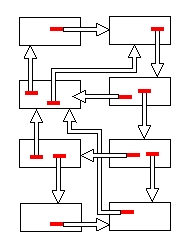WWW wird umgangssprachlich oft synonym zu Internet verwendet.
|
WWW wird umgangssprachlich oft synonym zu Internet verwendet. |
|
Internets Hypertext URL (Uniform Resource Locator) Links aufgerufen werden. Das WWW beruht auf einem Vorschlag von T. Berners-Lee, in welchem es im wesentlichen darum ging, das Internet als Plattfom für einen möglichst universellen Dateitaustausch zu benutzen. Damit möglichst viele Computertypen miteinbezogen werden konnten, wurde ein rigides Protokoll entwickelt, dessen Hauptmerkmal HTML-Dateien sind, die durch Browser angeschaut werden. Geschichte des WWW:
Wie sich das WWW dann tatsächlich entwickelt hat, ist eine etwas kompliziertere Geschichte. Die Entwicklung von Browsern ist ein technischer Aspekt davon. Wichtig war aber wohl auch die Verbreitung des e-mails, wodurch ganz viele private PC an das Internet angeschlossen wurden. Anmerkung:
Seit etwa 2005 gibt es das sogenannte Web 2.0, was im wesentlichen eine Software bezeichnet, die wie etwas das Facebook hinreichend massenfähig ist. |

|
Ende 2008 zählten die Webexperten über 186 Millionen Websites, fast 32 Millionen mehr als Ende 2007. Interessant: über 51% der Sites werden mit dem Betriebssystem Apache betrieben, das als OpenSource-Software klarer Marktführer ist. Microsoft bringt es mit seiner Server-Software nur auf einen Anteil von gut 33%.
Ein paar wichtige Konzeptdifferenzen
Das dem Hypertext zugrunde liegende Konzept stammt von früheren Entwicklungen ab, wie Ted Nelsons Projekt Xanadu, Vannevar Bushs „memex“-Maschinenidee und dem Note Code Project.
Das World Wide Web unterscheidet sich von damaligen Hypertext-Systemen (Note Code benutzte beispielsweise eine einfache und lesbare Syntax und semantische Deskriptoren). Das WWW benötigt nur unidirektionale Links statt bidirektionaler, was es ermöglicht, einen Link auf eine Ressource zu setzen, ohne dass deren Besitzer eingreifen muss. Zudem baut das World Wide Web – anders als andere Protokolle wie HyperCard oder Gopher – auf einem freien Protokoll auf, was die Entwicklung von Servern und Clients ohne Beschränkungen durch Lizenzen möglich machte. Tim Berners-Lee machte das World Wide Web-Projekt am 6. August 1991 mit einem Beitrag zur Newsgroup alt.hypertext öffentlich und weltweit verfügbar.